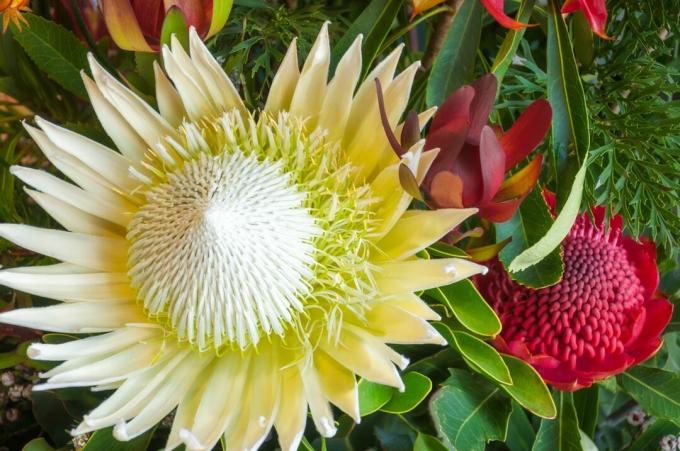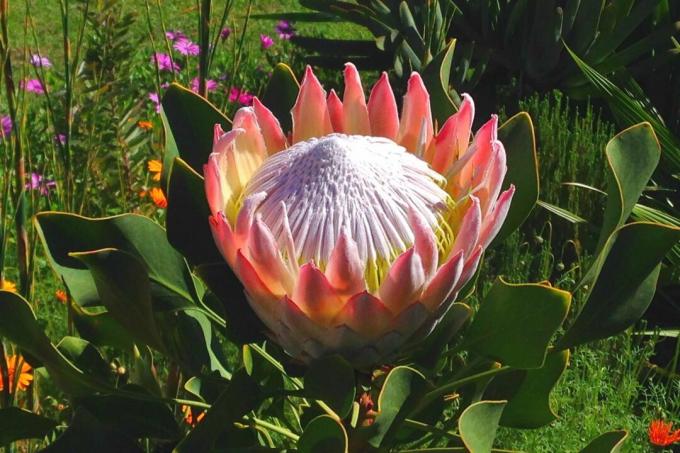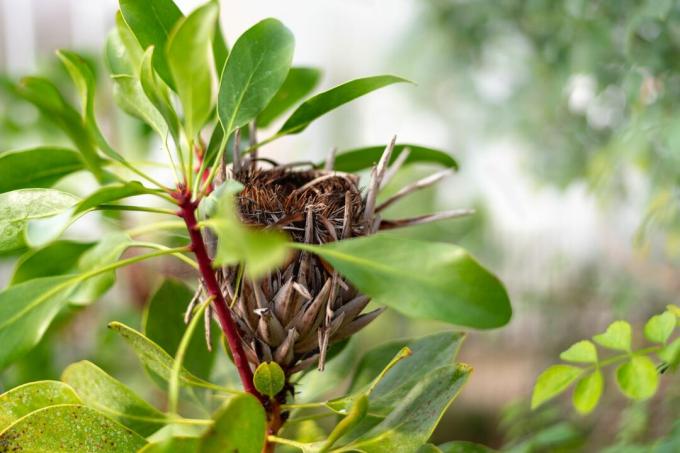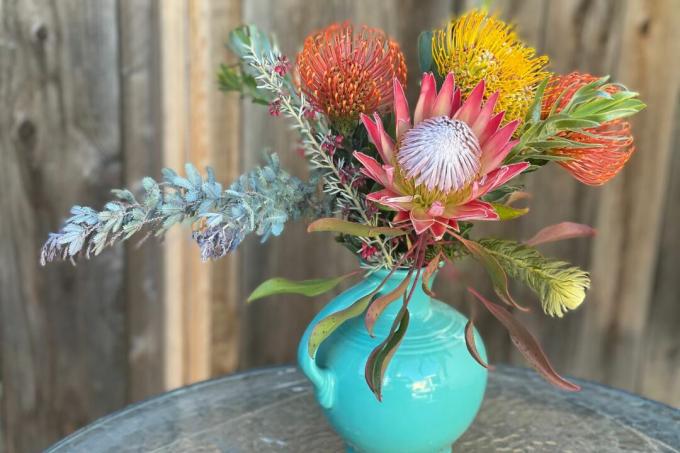Its flowers can be the size of a plate and are not only eye-catchers in pots, but also in bouquets or as dried flowers. We're talking about the protea.

Various species of the genus Sugarbush (protea) can be kept as pot plants in the house and in mild locations in the garden. You can find out here which location is suitable and how to properly care for them.
contents
- Protea: origin and characteristics
- The most beautiful Protea species and varieties
- plant protea
- The right care
- Propagation via cuttings and seeds
- Protea as a cut flower in a bouquet
- Dry and preserve protea
Protea: origin and characteristics
The Sugar Bushes (protea) form a plant genus that includes about 100 species. The evergreen shrubs native to southern and tropical Africa belong to the silver tree family (Proteaceae). More names for the protea are Federbusch, Silberbaum or Kaprose. Sugar bushes naturally occur mainly in higher mountainous areas. Some species form a thickening, the lignotuber, at the base of the trunk, which serves as fire protection, so to speak. After a fire, the sugar bushes can sprout again. The seeds are also in very hard shells, which only break open after a fire, which means that germination only takes place after a fire.
The sugar bush inflorescences, which consist of a number of small individual flowers and are often surrounded by very decorative, colored bracts, are particularly characteristic. Due to the bracts that surround the inflorescence, the flower looks a bit like an artichoke. The flowers can be up to 30 cm in diameter.
The leaves are leathery and entire and, depending on the species, are distributed on the shoot or can only be found at the upper end. The varieties differ greatly in growth height, which ranges from 1 to 10 m.
Some proteaspecies can also be kept as potted plants. The is popular protea also when dried as a decoration in a vase. A particularly magnificent species is the royalprotea (Protea cynaroides), which we often use as an ornamental plant.

Is the protea poisonous? Yes the protea is poisonous and should not be consumed. Consumption can irritate the mucous membranes.
The most beautiful Protea species and varieties
The most popular protea-Species that are also suitable for pot culture in the apartment and on the balcony are available in different varieties with differently colored bracts.
king protea (Protea cynaroides): Makes creamy white or pink flowers up to 20 cm in diameter. It is a particularly magnificent species, with varieties available in different colours.

- 'White Crown': With white-soft green bracts
- 'Little Prince': With red bracts
- 'Mini King': A short cultivar, reaching heights of 60-90 cm
Oleander-leaved Protea (protea neriifolia): The bracts of this species are purple and hairy at the top. The bracts are bent together at the top, so that one can only guess at the flower. But that doesn't matter, because it's usually the colorful bracts that are so striking on the sugar bush.

- 'Pink Ice': With bracts in pink
- 'Alba': Here the bracts are whitish-light green
- 'Australian Ruby': Reddish-pink bracts that lighten towards the top
plant protea
In our latitudes, the protea usually kept in pots or tubs and only spends the summer outdoors. In winter it is placed in a sheltered place because it does not tolerate the low temperatures. You can only do this in very mild regions, for example in wine-growing areas protea also plant in the bed. Lowest temperatures of around – 7 °C are still tolerated. Do you want one? protea plants, a suitable substrate is first necessary. This is not easy to buy because the natural location of the protea is very special. So make the substrate yourself: it should be low in nutrients, permeable and slightly acidic. Sugar bushes require a soil pH of four to six. For permeability, a nutrient-poor, phosphate-poor soil should be mixed with a third of sand. A mixture of two parts sand, two parts softwood soil and one part perlite is ideal. In addition, a drainage layer, for example made of expanded clay or potsherds, on the bottom of the pot is important so that the irrigation water can drain off. Waterlogging is from the protea namely not tolerated at all. To keep the soil constantly moist, but to counteract waterlogging, you can also use a mulch layer, for example from our Plantura organic pine bark, to be deployed. Not only does it look beautiful, it also has a slightly acidic effect on the soil, reduces water evaporation from the soil and prevents unwanted weeds from sprouting. In addition, it has an isolating effect, so that the root of the protea not subject to sudden temperature changes.
An ideal location for the protea is bright, warm and characterized by noticeable air movement. It can also be sunny, but stagnant air should be avoided, as this promotes the occurrence of plant diseases on the soil protea .

Tip: Since the protea unlike other plants can not control the absorption of phosphorus, it occurs in phosphorus-containing substrates quickly lead to phosphorus poisoning because the plant has absorbed too much of the nutrient element. This first manifests itself in yellowing of the leaves, later also in leaf tips drying up and whole leaves or in a shortening of the internodes, i.e. the distance between the leaves on the shoot.
The right care
In order for the sugar bush to develop well and remain healthy, the care of the protea a little tact required. It is important that protea in cooler regions from the end of October in a bright, frost-free place at around 10 °C. A conservatory, for example, is suitable for this. From the beginning of April she can go outside again.
When pouring the protea care must be taken to ensure that the roots do not dry out completely, but that the plant is never damp. The goal is a very low but constant moisture level in the soil. Rainwater is suitable as irrigation water because it is naturally slightly acidic. Hard water should be boiled or mixed with distilled water. From time to time the sugar bush or its mineral mulch should also be sprayed with lime-free water, because some species do not tolerate very dry air.
The nutrient requirement of the sugar bush is rather low according to its natural habitat. It therefore does not have to be fertilized at all. In the vegetation period from April to September, however, occasional fertilizers lead to richer flowering. In the first year after planting, a little long-term fertilizer, such as ours, can therefore be used in spring Plantura organic flower fertilizer, incorporated into the top substrate layer. This contains phosphorus in a slowly available form, namely as rock phosphate. This can prevent the plant from absorbing too much phosphorus at once. However, the fertilizer should only be used in half the dosage for flower boxes so that too much phosphorus is not added. The other nutrients contained ensure a healthy plant with magnificent flowers.
the protea tolerates a maximum of 40 mg of elemental phosphorus per kilogram of root-penetrated soil. This should be considered when choosing the fertilizer.
After flowering can withered protea-Blossoms are cut off, because removing the blossoms improves the further blossoming.
Is the Protea hardy? the protea is not hardy because the winters in our latitudes are too cold for the plant in the southern hemisphere. In mild regions where it doesn’t get colder than – 7 °C, the protea stay outside in winter but should be protected by a layer of mulch to be on the safe side. In cooler regions it should be overwintered in a cool place, at around 10 °C, in a bright place, for example in the conservatory.
Propagation via cuttings and seeds
Propagating the sugar bush is not easy. In principle, propagation is possible via seeds as well as cuttings.

Since the protea as indoor plants usually do not produce fruit due to a lack of pollinators, the seed is purchased from specialist retailers. the protea-Seeds are sown in spring at temperatures of 10 to 15 °C. The temperature differences between day and night are important for germination, so sowing must be done outdoors. Before sowing, the seeds must be soaked in room-warm water for about 24 hours. The effect of pre-soaking is enhanced by adding about three teaspoons of wood ash per 100 ml of water. Alternatively, place the seeds on a fireproof tray, cover them with 6 to 10 cm of dried fern leaves and burn them. The ashes are then moistened. Then the seeds are placed in slightly acidic, permeable and phosphate-free potting soil. A suitable mixture can be achieved, for example, with two parts sand, two parts softwood soil and one part perlite. The seeds are only distributed on the ground and very lightly sieved, because they are light germs. The substrate is kept moist, but not wet. Germination occurs after four weeks to four months.

To the protea To propagate via cuttings, you first need a healthy mother plant and a suitable growing medium. The substrate is obtained, for example, from a mixture of two parts quartz sand and one part sphagnum moss. Using a sharp, clean knife, cut off a shoot about 5 to 10 cm long from the mother plant at an angle. It shouldn't be lignified yet, but it shouldn't be green either. The leaves on the lower part of the cutting are removed and the cutting point is dipped in rooting powder. Now the cutting can be inserted into the substrate, which is then moistened well. It should be placed in a warm, bright place. High humidity is also necessary and can be achieved by occasional spraying. In good conditions, roots will form after about four weeks.
Protea as a cut flower in a bouquet
the protea is a flower that is one of the most durable plants when cut in a bouquet. You cut them off at the desired point with a sharp knife and put them in a vase with water. This should be replaced every few days. The sugar bush can be kept in the vase for up to three weeks.

Dry and preserve protea
To enjoy the beautiful bloom of the for a long time and without much effort protea to have, you can dry them. To do this, cut off the flower, including the stem, at the base and hang it upside down, tied to a string, for example. So you leave them hanging in a warm, air-dry room. Is the protea Once dried, you can put them in an empty vase individually or together with other dried flowers.
Whom the attitude of protea is too time-consuming, you can look around for houseplants that are a little easier to care for. Less with flowers, but with pretty leaves, for example, convinces Alocasia zebrina as a houseplant.


